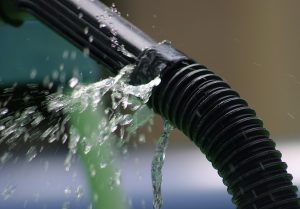When you consider the possibility of water damaging your property and your home, you might come up with an image of a severe weather event such as a hurricane, monsoon-like rain or other natural disaster. The sad reality is that water damage caused by ordinary household appliances which have failed might be just as costly and as a severe weather event!
Looking at damage claims information from the Insurance Industry Institute, problems caused annually by damage from water represent billions of dollars in property losses to renters and homeowners. Water is also responsible for causing approximately 25 percent of all claims turned in as property insurance claims. In fact, information from the Travelers Insurance Company as reflected by data from its Claim records shows that water is ten times more likely than fire to cause damage to your home.
But how can you have “drills” to keep leaking water from catching you by surprise? Luckily,, there are some simple steps that you can take to help prevent damage from water seeping from various innocent-looking appliances, and further help you protect your home. It is important to understand some of the potential sources of this unexpected and unforeseen water. Damage can be caused by water unexpectedly leaking from various sources: heating along your baseboards, recepticles that fail to catch or drain condensation from an indoor air conditioning unit, and even poorly functioning water heaters. Other culprits guilty of leaking water are hoses attached to washing machines, and all models of basic standard household plumbing installations, and bathroom plumbing fixtures.
These household items rarely broadcast to their humans that they are going to leak; the evidence appears after the leak has already started. Once the leak begins and becomes noticeable, the damage has already occurred. Because of this uncertainty, it is important to establish a way to check the disaster – makers according to a regular schedule with check dates spread throughout the year. Keep a simple calendar to organize your periodic checks.
The following simple steps offered below can help you identify disaster before it hits and can protect your home from the most frequent causes of water damage:
- First, know how to cut off your entire water supply. You need to know where the main water supply and cut off devices are located in case of emergency.
- If you plan to be away from home for a lengthy period of time, shut off the water supply and drain the pipes of any residual water left in them. During the heating season, if you are in an older home, determine whether your home is heated by an older steam heating system. If so, consult with your heating professional to determine if it is safe to turn off the water supply for your particular heating system. Also, if your home is protected by a fire sprinkler system, do not turn off the water to this system. However, your home needs to maintain sufficient heat to prevent a freeze-up in your sprinkler system or the pipes connected to the sprinkler system could easily burst within the walls and ceilings concealing them.
- Consider having your air conditioning system inspected regularly by an HVAC professional. Review the state of the drain lines annually and clean them if they are clogged.
- Inspect water heaters, showers, tubs, toilets, sinks and dishwashers annually, and have them repaired if there are any signs of leaks or corrosion. Those sogns point to escaping water! Whenever possible, install water heaters in areas that already have floor drains to minimize water damage if leaks should occur.
- Check any caulking around bathroom fixture, including showers, bathtubs, sinks and toilet bases, to be sure none of it is loose, and make repairs as needed.
- If your refrigerator has an ice machine or water dispenser, the hose between the wall and the refrigerator should be made of braided copper, which has greater cracking and corrosion resistance.
- Check pipes for cracks and leaks. Have any visible pipe damage fixed immediately to prevent more costly repairs in the future.
- Check appliance hoses and plumbing fittings for breakage, crimping or bending. Be sure that the hoses are not so old that they have become brittle; brittle hoses can crack and allow water to seep out.
- If you are unfamiliar with any of this or suspect that you might have a problem, you can probably have your home reviewed by a local home inspector. For a small professional fee, that inspector can run through this checklist, isolate any potential repairs, and give you peace of mind.
